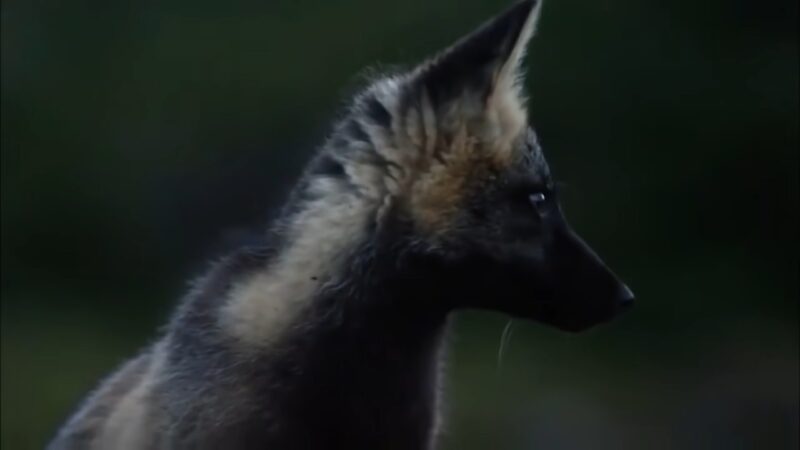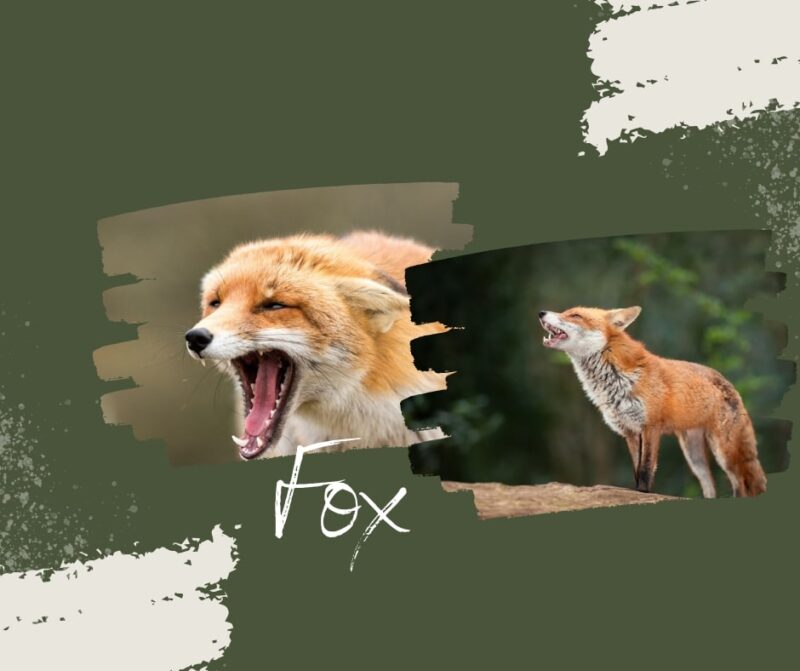In the hushed hours of the night, when the urban hum fades into the distance, and the tranquil countryside resonates with the chorus of the wild, a sudden, eerie scream pierces the calm. To the uninitiated, this sound can be chilling, even terrifying. Yet, these haunting cries belong to a familiar nocturnal dweller – the fox.
Their extraordinary vocal range serves various purposes, from asserting dominance to attracting mates. The intriguing phenomenon of their nocturnal screams, in particular, has baffled and fascinated humans for ages.
Today I aim to uncover the mysteries behind fox vocalizations, with a special emphasis on their nighttime screams. By exploring the intricacies of their communication, the reasoning behind them, and the significance of these sounds in the broader context of their behavior, we will demystify this enigmatic aspect of the fox’s existence.
The Screams
One of the most iconic and enigmatic sounds in the fox’s vocal repertoire is the scream. These sounds are hauntingly human-like, often mistaken for the cries of a distressed individual. The high-pitched, wailing nature of these sounds makes them particularly noticeable, contributing to their mystique.
Distinguishing a fox scream from other animal sounds requires a keen ear. The distinctive characteristic of their scream is its long, drawn-out, and somewhat raspy nature, often escalating towards the end.
They can vary in tone, duration, and intensity, making them unique among the symphony of night sounds. These calls, while somewhat disconcerting, are a natural part of their behavior. They are an integral part of their communication system, serving specific purposes that extend far beyond merely haunting our nights.
What’s the purpose?
The question arises – why do foxes scream at night? These calls primarily serve two main functions: as mating calls and as signals in territorial disputes. These sounds, as alarming as they may seem to us, are part of their natural behavior and play an essential role in their survival.
During the mating season, they become particularly prevalent. Female species, or vixens, use these sounds to signal their availability to potential mates. Simultaneously, males may use them to compete with other males, asserting their dominance and vying for the attention of available vixens.
On the other hand, these sounds also play a crucial role in territorial disputes. Foxes are fiercely territorial creatures, and these calls can serve as a warning to other foxes, signaling them to keep away. Therefore, each scream is a nuanced message, either inviting mates or warding off intruders.
Mating Calls and Sexual Selection

In the context of sexual selection, these sounds serve a fascinating purpose. These haunting cries are, in fact, alluring melodies for foxes.
They act as mating calls, broadcasting the presence of a vixen in heat to potential mates in the vicinity. Male species are naturally drawn to these calls. The stronger and more robust the sound, the more likely it is to attract a mate. In this sense, the screams are a siren song in the fox world, a signal that the time for mating has arrived.
While these vocalizations are part of their courtship ritual, they are also indicative of the broader concept of sexual selection in action. The most vocally attractive animals tend to attract more mates, which in turn influences the gene pool of future generations.
These sounds, as eerie as they might seem, play a pivotal role in the survival and propagation of the mentioned species.
Territory Marking and Communication
Territory is of paramount importance to a fox. In the wild, its territory is its lifeline, providing access to food, shelter, and mating opportunities. These sounds are a powerful tool in marking and defending these territories. It is a clear proclamation of ownership, announcing to other species that a particular territory is already claimed.
They are a vocal equivalent of a “Keep Out” sign, designed to deter potential intruders. Moreover, these calls serve as an important mode of communication between foxes. By varying the intensity and frequency of these sounds, they can convey different messages, ranging from a simple assertion of presence to a strong warning of aggression.
Thus, understanding these sounds means understanding the language of territoriality in the world of foxes.
Defending Against Intruders

These calls are not just about communication and courtship – they are also a show of strength. When an intruder threatens its territory, the fox uses its scream as a powerful weapon of deterrence.
The intensity of the sound can convey a great deal about its willingness to defend its territory. A louder, more frequent scream suggests a fox ready to fight to protect its domain. In contrast, less aggressive sounds might indicate an animal less inclined to risk a direct confrontation.
At times, these serve as warning signals to other animals beyond just their species. The loud, abrasive nature of these screams can deter potential predators or other unwelcome guests. This defensive use underscores the crucial role vocalizations play in a fox’s survival strategy.
The Impact of Seasonal Factors
These calls are a frequent soundtrack of the night, but their frequency and intensity can vary depending on the time of year. Seasonal changes significantly impact fox vocalizations, including their nighttime screams.
The mating season, typically occurring in late winter and early spring, is a particularly vocal time. The need to attract mates and compete with rivals for mating rights leads to an increase in the vocalizations. During this period, the nighttime chorus of these sounds can reach a fever pitch.
On the other hand, during the non-mating season, these sounds tend to be less frequent, primarily used for asserting territorial claims. Understanding this seasonality can help humans better appreciate and coexist with these nocturnal singers.
The Vocal Repertoire

While fox screams are undoubtedly the most notorious, they are but one element of a diverse vocal repertoire. These animals are capable of producing a wide range of sounds, each serving a specific function in their complex social structure.
They can bark, howl, whine, and even “gekker,” a rapid series of high-pitched barks used during intense interactions with other foxes. Each of these vocalizations communicates different messages, from signaling danger to expressing submission.
Furthermore, variations in vocalizations exist among different species. For instance, the red fox, the most common species, is known for its blood-curdling scream, while the Arctic fox has a comparatively softer, more coyote-like howl. These differences highlight the rich diversity and complexity of their vocalizations.
Myths and Misconceptions
These interesting calls have long been the subject of various myths and misconceptions. Their eerie, human-like quality has given rise to numerous folk tales and superstitions, many of which paint these vocalizations in a rather negative light.
Some believe that they are ominous signs of impending danger or even death. Others associate them with supernatural entities, further fueling the fear and mystery surrounding these sounds. However, as we’ve learned, fox screams have a purely natural origin and purpose, tied closely to the animals’ survival and propagation.
Dispelling these myths and misconceptions is critical for promoting understanding and appreciation of these fascinating creatures.
Human Interactions and Reactions

Fox screams are an unexpected and, for some, an unsettling aspect of human-wildlife interaction. People who have heard them often describe the experience as unsettling or even frightening, given the scream’s eerily human-like quality. I am among these people and I couldn’t agree more.
Cultural beliefs and folklore around these vocalizations vary widely across the globe. In some cultures, they are considered bad omens or warnings of supernatural events. Meanwhile, others view these sounds with a sense of wonder and curiosity.
These diverse reactions offer a fascinating glimpse into human perceptions of wildlife. They remind us that our understanding and interpretation of nature are often shaped as much by culture and folklore as they are by scientific knowledge.
Urban Foxes and Nighttime Screams
With urbanization encroaching on their natural habitats, foxes are becoming an increasingly common sight in cities and towns. This shift has led to an increase in encounters with the vocalizations, particularly during the night when these creatures are most active.
Urban environments provide ample food and shelter opportunities for the animals, with the lack of natural predators making them attractive habitats. Consequently, the urban fox population has been on the rise in recent years.
However, this increase in populations has also led to increased friction between humans and foxes. The nocturnal screams, especially, have been a source of disturbance and intrigue for many city dwellers.
Coexistence and Appreciation

Our exploration of the above mentioned sounds reveals an intricate tapestry of natural behaviors, ecological roles, and evolutionary adaptations. Recognizing and appreciating these aspects is crucial for fostering a harmonious coexistence with these fascinating creatures.
Living alongside foxes, whether in urban or rural settings, doesn’t have to be a source of conflict. With understanding and tolerance, we can appreciate the unique behaviors of these animals, including their haunting screams, as part of the rich tapestry of nature that surrounds us.
We can also contribute to this peaceful coexistence by ensuring our actions don’t disrupt or threaten their natural behaviors. Simple measures, such as securing our waste and maintaining a respectful distance, can make a big difference in preserving the natural balance.
FAQs:
Can loud noises or human disturbances cause foxes to scream more frequently?
Loud noises or human disturbances can potentially trigger more frequent vocalizations, including screams, as they may perceive them as threats.
Do they scream when they are threatened by predators?
Foxes generally do not scream when threatened by predators. Instead, they rely on evasive maneuvers and hiding to protect themselves.
How far can these sounds be heard?
They can be heard from a distance of up to several miles, depending on factors such as environmental conditions and surrounding noise.
Do foxes scream when they are hunting prey?
They do not typically scream when they are hunting prey. They rely on stealth and silence to catch their prey.
Can other animals mistake these sounds as a call for help?
Other animals may mistake them as a call for help, as they can resemble distress calls. However, they are primarily used for communication within the fox community.
Conclusion
As we’ve journeyed through the captivating world of fox vocalizations, it becomes clear that these are far from a sinister mystery. Instead, these intriguing sounds are a testament to the complex social behaviors, mating rituals, and territorial assertions that underpin the life of a fox.
These sounds, echoing in the stillness of the night, are a reminder of the rich, wild tapestry of life that unfolds alongside our own. They offer us a glimpse into the life of an often misunderstood creature, revealing a world of communication, competition, and courtship.
So, the next time you hear the haunting scream of a fox piercing the quiet of the night, pause for a moment. Behind that eerie sound is a story of survival and adaptation, a melody of nature that is as fascinating as it is haunting.
Related Posts:
- Why Do Frogs Scream? Are these or Help or Something More?
- Are Foxes Canines? - Let's Unveil The Truth
- How Do Red Foxes Survive Winter? Survival Guide
- What Do Foxes Eat? Wild & Urban Fox Diet Info & Habits
- Why Do Moose Have Antlers? - From Decoration to Weaponry
- Why Do Moths Eat Your Clothes? - Wardrobe Woes








